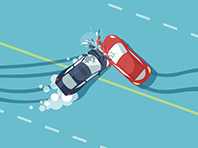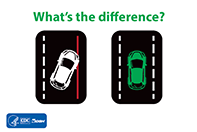Behind the Wheel at Work

Behind the Wheel at Work is an eNewsletter bringing you the latest news from the NIOSH Center for Motor Vehicle Safety.
Volume 4 Number 4 December 2019
Let’s Talk…
…about leadership updates, new products, and resolutions. What will you do to keep drivers safe on the road in 2020? Catch up on previous issues of our newsletter.

Thank you to Stephanie Pratt for directing the Center for Motor Vehicle Safety (CMVS) since 2010! With Stephanie’s upcoming retirement, Dawn Castillo is now the Manager of the CMVS. Rosa Rodríguez-Acosta remains involved in the CMVS as Assistant Coordinator. Congratulations to Kyla Retzer, who recently began her new role as CMVS Coordinator! Keep reading to view Stephanie and Kyla’s conversation about motor vehicle safety (MVS).

With colleagues from Miami University and the Network of Employers for Traffic Safety (NETS), NIOSH CMVS researcher Dr. Stephanie Pratt co-authored a journal article on 2016 collision and program data for 70 U.S. fleets operated by NETS member companies. The NETS data covered 70 fleets, almost 333,000 vehicles from passenger cars to tractor-trailers, a variety of industries, and almost 5.5 billion vehicle miles driven. The analysis used motor vehicle safety (MVS) data submitted by these companies, along with their responses to a detailed questionnaire about elements of their MVS program.

Motor vehicle crashes and violence are leading causes of taxi driver deaths. Evidence shows that fatigue is associated with both violence and crashes among this worker group. Keep reading to learn about recent publications related to taxi drivers.
Survey Results on Driver Fatigue
To better understand injuries among taxi drivers, NIOSH investigators developed a survey asking about a wide range of work (e.g., shift and taxi driving tenure) and social (e.g., demographics and safety climate) factors. In 2015, a total of about 1,000 taxi drivers in two large western and southwestern U.S. cities responded to the 30-minute survey. According to the survey results published in the Journal of Safety Research, most of the drivers reported driving while tired. Get more survey highlights in this issue of NIOSH Research Rounds. Key findings were:
- Taxi drivers who reported receiving useful road safety training were less likely to drive while tired.
- Taxi drivers who reported greater job demands were more likely to drive while tired.
- Drivers who reported that safety was a high priority for their company were less likely to drive while tired.
- In the southwestern city, drivers who reported a negative safety climate were more likely to report driving while tired.
- In both cities, drivers who reported driving while tired were also more likely to have reported experiencing passenger violence during the past 12 months.
Fast Facts About Violence Prevention
The most serious workplace violence issues facing taxi drivers are homicide and physical assaults, which are often related to a robbery. View NIOSH Fast Facts for specifics about these 4 strategies to prevent or reduce the likelihood of violence during a shift:
- Greater visibility into your taxi can help reduce violence.
- Less cash in your taxi makes you a less likely target for robbery.
- Ask your cab company to equip your taxi with safety measures.
- Prepare for possible unsafe situations with customers.

We’ve added some new online resources! Visit our Driver Fatigue on the Job webpage for data and recommendations related to driver fatigue. Look for CMVS Evaluation 2014-2018 materials on our Research Program webpage. Stay tuned for the new CMVS Strategic Plan 2020-2029

What’s the difference between Lane Departure Warning and Lane Keeping Assist? View the new Safety Feature GIF for the answer. Also, check out our other new animated image, Speeding GIF, for a message about how speeding increases likelihood of a crash, injury, and death.
Questions? Comments? Email kur4@cdc.gov.
Enter your email address to receive research updates, links to motor vehicle safety resources, practical tips on workplace driving, and news about upcoming events.




